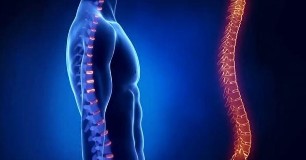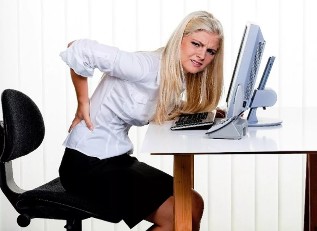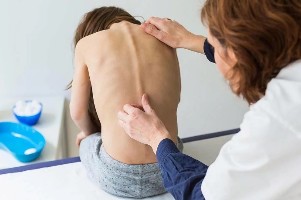Osteochondrosis is a degenerative lesion of the articular cartilage and underlying bone underneath the tissue. Disease affects all joints of the musculoskeletal system. In the domestic medicine called osteochondrosis complex degenerative processes in the intervertebral discs and small joints of the spine and the vertebrae.

What is osteochondrosis?
Osteochondrosis of the spine is the cervical, thoracic and lumbar. The type of the disease is determined by the location of the changed tissues. The basis of pathology is a violation of trophics intervertebral discs and vertebrae. It leads to a change in the normal structure of cartilage. As a result of degeneration of the cartilage disc loses elasticity, changes consistency and form. Decrease the gaps between the vertebrae and the affected segment of the spine loses stability.
A reduction in the distance between the vertebrae is accompanied by tension of the back muscles, compression of the nerve root extending from the spinal cord. This explains the onset of pain and neurologic symptoms of osteochondrosis.
Disc degeneration leads to weakening of the outer fibrous ring. Therefore, patients with degenerative disc disease often occur protrusion (bulging part of the disc) and hernia (overhang nucleus pulposus of the disc into the spinal canal). In the future, the pathology spreads to the small joints of the spinal column, the intervertebral ligaments:
- occur bony growths of the vertebrae;
- patient is hard to bend and unbend;
- lost flexibility of the spine;
- appear subluxations of the vertebrae;
- bend the affected area of the spine (kyphosis, scoliosis).
Degenerative changes in cartilage and bone tissue are a normal result of aging. For a number of reasons the development of the pathology can be accelerated. 70% of patients with low back pain — people above 45 years. The early appearance of the pathology is associated with poor physical fitness of children overweight in adolescents.
Today's youth spends a lot of time at the computer and TV, avoiding outdoor games, outdoor walks and sports not knowing what is osteoarthritis and how dangerous it is. Long stay in a sitting position promotes:
- violation of posture;
- the weakening of the back muscles;
- the development of spinal problems.

The causes of osteochondrosis
The causes of disease are divided into 3 groups. The first is the increased load on the spine:
- overweight;
- heavy physical work (especially cargo lifts);
- occupations that require prolonged standing or sitting;
- wearing of uncomfortable shoes, high heels, bags only on one shoulder;
- incorrect posture;
- underdeveloped muscular frame due to a sedentary lifestyle;
- congenital and acquired deformities of the spine;
- flat feet.
The second group includes internal reasons:
- heredity;
- age-related changes;
- metabolic disorders;
- intoxication;
- emotional tension, stress;
- serious somatic diseases;
- hormonal changes (e.g. pregnancy, menopause);
- autoimmune connective tissue disease.
The third group consists of external factors:
- injuries of the spine;
- the lack of vitamins and mineral compounds (especially vitamins D, C, b group, calcium and phosphorus);
- bad habits;
- sleeping on an uncomfortable mattress and pillow.
Professional sports become the reason for premature aging of the intervertebral discs at every 20th athlete. The process of degeneration is accelerated after the abrupt termination of training.
Symptoms of degenerative disc disease
Osteochondrosis is a chronic disease, characterized by alternating periods of exacerbation and remission. The development of acute symptoms contribute to:
- excessive physical load;
- fatigue;
- hypothermia;
- injury;
- body shake and vibration.

The clinical picture of acute exacerbations depends on the location of the affected cartilage, the presence of complications.
- For cervical degenerative disc disease characterized by pain in the neck, arms, stiffness, numbness of fingers, headache. If the vertebral artery is pinched, the human condition is deteriorating: there is throbbing headache, severe dizziness, reduced hearing, there "to see spots", possible fainting.
- Signs of osteochondrosis of the thoracic: concerned about sharp or aching pain, feeling of "stake in the chest", pain in the heart and the internal organs, shortness of breath (hard to breathe on the full chest due to stiffness of muscles and pain).
- While lumbar degenerative disc disease causes pain in the lower back, sacrum and legs, worse while walking. There's a shot in the lower back during exercise, numbness of lower extremities. Appear dysfunction of the urogenital organs (pain, impaired urinary function, problems with potency in men, dysfunction of the ovaries in women). During remission the patient feels a slight pain that only occurs under the influence of precipitating factors (stress, forced awkward postures and other things).
Low back pain and IRR
Pathology in the intervertebral joints often lead to pinching of nerve roots, blood vessels that feed the brain, irritation of autonomic nodes that are responsible for the functioning of internal organs. These factors cause disorders of the cardiovascular and nervous systems. In 8 of 10 patients with osteochondrosis develops the syndrome of vegetative-vascular dystonia (VVD), whose symptoms are:
- sudden changes in blood pressure;
- headaches;
- nausea and vomiting;
- sleep disturbance;
- shortness of breath;
- chills or hot flushes;
- General fatigue.
In severe cases, loss of consciousness.
In 95% of cases, the correlation between the health of patients and conditions.
Described symptoms accompanied not only by low back pain. Patients with a similar clinical picture in need of examination to exclude somatic and endocrine abnormalities.
Diagnosis of degenerative disc disease

The patient needs to know what kind of doctor treats low back pain, just to get on to the correct specialist. The spine involved a neurologist, and should be referenced for pain in the back, neck, and lower back. Examination of patients with suspected degenerative disc disease takes place in stages and can take from 1 to 7 days:
- survey;
- external examination of the spine in different body positions (lying, sitting, standing);
- palpation of the vertebral column located around the soft tissue;
- definition of range of motion in different parts of the spine;
- instrumental studies: computed tomography, nuclear magnetic resonance, x-ray.
When a difficult diagnosis is carried out specific studies of blood vessels and peripheral nerves.
How to treat osteochondrosis?
Treatment of osteochondrosis of the spine is long and requires a comprehensive approach. Therapy used medication and physiotherapy methods — selecting individual approach to each patient. The choice of therapeutic scheme depends on:
- the severity of the pathology;
- the condition of the patient;
- the presence of complications of the disease.
An important condition for effective treatment of osteoarthritis – a step-by-step. The primary goal of therapy during exacerbation of the disease — pain management. It is recommended that the patient rest, wearing special corsets and collars for unloading of the spine. Applied internal and external treatment medicines, undergoing physiotherapy. In the next step carry out actions that prevent a new aggravation:
- therapeutic physical training (physical exercises to strengthen muscles and develop correct posture);
- therapeutic massage;
- chiropractic;
- reflexology etc.
Medication
Drug therapy in osteoarthritis is aimed at pain management, the regeneration of cartilage tissue, improve microcirculation and nutrition in affected segments of the spine. Patients prescribed:
- pain relievers: nonsteroidal anti-inflammatory drugs (tablets, injections, ointments, etc.);
- muscle relaxants to relieve muscle tension that appears when degenerative disc disease causes pain;
- local anesthetic treatment – compresses with novocaine, medicinal blockade, capsicum plaster and so on;
- chondroprotectors that contribute to the regeneration of the cartilage;
- vitamins and minerals in tablets or as solutions for injections;
- vasodilator drugs to eliminate the reflex spasm of the vessels;
- drugs for the normalization of metabolism in tissues.

Physiotherapy
Physiotherapy or physical therapy in osteochondrosis promotes the formation of a strong muscular corset, which provides uniform distribution of load on the spine. Regular classes:
- improves circulation and nutrition of tissues, intervertebral discs;
- produced the correct posture;
- increases range of motion in the spine.
Breathing exercises relieve muscle spasm and pain, and swimming unloads and relaxes the spine.
Physiotherapy and rehabilitation training on simulators is performed after decrease in acute symptoms of the disease.
Basic rules for exercise:
- the regularity (the exercises must be done every day);
- gradualism (the first sessions last 10-15 minutes, each week you need to increase the duration by 5 minutes for 2 months);
- moderation (after exercising the patient feels easy fatigue, exhaustion after gymnastics – a sign of an incorrect approach to physical therapy).
Exercises should not cause discomfort. When the pain in the back of class to stop and discuss with your doctor the possibility of further training.
Auxiliary methods of treatment of osteochondrosis
Complex conservative treatment of degenerative disc disease in addition to drug therapy and physical therapy, includes:
- massage: helps to relieve muscle spasm, eliminate pain and improve blood circulation in the tissues;
- manual therapy;
- physiotherapy: massage, laser therapy, magnetotherapy, impact of ultrasound;
- traction of spine using special equipment;
- reflexology and acupuncture: impact on reflex zones of active points and relaxes and relieves back pain.
Prevention of osteoarthritis
Osteochondrosis it is necessary to reduce the load on the spine:
- wear comfortable, quality footwear;
- to avoid a long stay in an awkward position or in a standing position;
- to control body weight;
- to keep a correct posture;
- not to lift weights, and if necessary, evenly to use both hands to distribute the weight.

You should take care of the physical form and strengthen back muscles, you will have a daily General strengthening exercises, sessions in the pool, yoga.
An important part of prevention of degenerative disc disease is diet. You need to include in the diet:
- dairy;
- fish;
- broths;
- jelly;
- jelly;
- leafy vegetables;
- greens;
- olive and butter;
- eggs.
From carbonated drinks, alcohol, strong coffee, fatty meat and salty foods should be abandoned.
In General, to diagnose osteochondrosis is not so simple: it has no independent symptoms, often x-rays can detect problems in the spine in people who have never experienced long term back pain. The first bells for the occasion to go to the doctor can be severe headaches, pressure jumps, heaviness in the muscles, dizziness when turning the head. Often incorrect posture affect appearance: a hunched back and a pronounced hump, heavily arched back and round tight belly.
































